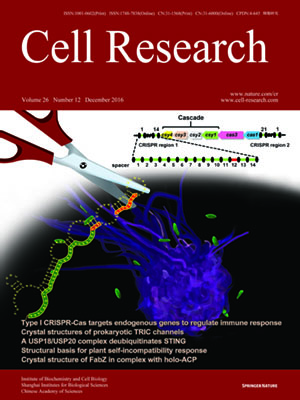
Volume 26, No 12, Dec 2016
ISSN: 1001-0602
EISSN: 1748-7838 2018
impact factor 17.848*
(Clarivate Analytics, 2019)
Volume 26 Issue 12, December 2016: 1273-1287
ORIGINAL ARTICLES
Type I CRISPR-Cas targets endogenous genes and regulates virulence to evade mammalian host immunity
Rongpeng Li1, Lizhu Fang1, Shirui Tan1, Min Yu1,2, Xuefeng Li1,2, Sisi He1,2, Yuquan Wei2, Guoping Li3, Jianxin Jiang4 and Min Wu1,2
1Department of Biomedical Sciences, University of North Dakota, Grand Forks, ND 58203-9061, USA
2State Key Laboratory of Biotherapy and Cancer Center, West China Hospital, Sichuan University, and Collaborative Innovation Center for Biotherapy, Chengdu, Sichuan 610041, China
3Inflammations & Allergic Diseases Research Unit, Affiliated Hospital of Southwest Medical University, Luzhou, Sichuan 646004, China
4State Key Laboratory of Trauma, Burns and Combined Injury, Institute of Surgery Research, Daping Hospital, Third Military Medical University, Chongqing 400042, China
Correspondence: Min Wu, E-mail: min.wu@med.und.edu; Guoping Li, E-mail: lzlgp@163.com; Jianxin Jiang,(hellojjx@126.com)
Clustered regularly interspaced short palindromic repeats (CRISPR)-CRISPR-associated (Cas) systems in bacteria and archaea provide adaptive immunity against invading foreign nucleic acids. Previous studies suggest that certain bacteria employ their Type II CRISPR-Cas systems to target their own genes, thus evading host immunity. However, whether other CRISPR-Cas systems have similar functions during bacterial invasion of host cells remains unknown. Here we identify a novel role for Type I CRISPR-Cas systems in evading host defenses in Pseudomonas aeruginosa strain UCBPP-PA14. The Type I CRISPR-Cas system of PA14 targets the mRNA of the bacterial quorum-sensing regulator LasR to dampen the recognition by toll-like receptor 4, thus diminishing the pro-inflammatory responses of the host in cell and mouse models. Mechanistically, this nuclease-mediated RNA degradation requires a “5′-GGN-3′” recognition motif in the target mRNA, and HD and DExD/H domains in Cas3 of the Type I CRISPR-Cas system. As LasR and Type I CRISPR-Cas systems are ubiquitously present in bacteria, our findings elucidate an important common mechanism underlying bacterial virulence.
10.1038/cr.2016.135
FULL TEXT | PDF
Browse 2170


